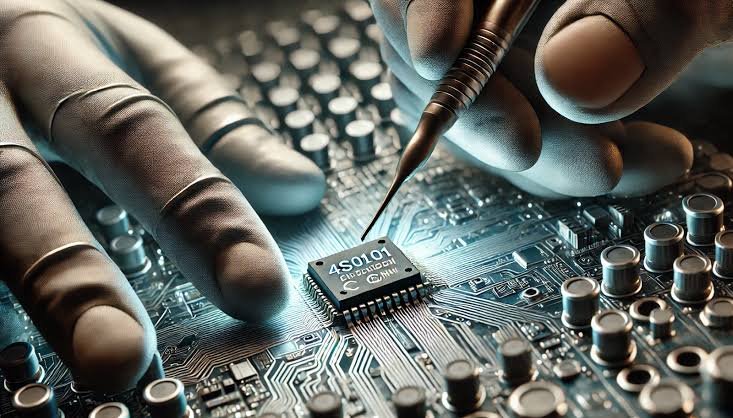Discover the Power of the 4S0101 IC
In today’s tech world, it seems like every day a new electronic component is developed that changes how devices work. One of these components is the 4S0101 IC, a highly efficient integrated circuit (IC) commonly used in various electronic projects. But what exactly is the 4S0101 IC, and why is it so important?
In this blog post, we’ll dive deep into what the 4S0101 IC is, how it works, and why it’s used. Whether you’re a beginner in electronics or someone just curious about this small but mighty chip, this guide will help you understand it better. So, let’s get started!
What Is the 4S0101 IC?
The 4S0101 IC is an integrated circuit, or IC, that plays a critical role in many modern electronics. Integrated circuits like this one are tiny chips that contain thousands (or even millions) of transistors, resistors, and capacitors all packed into a small space. These components work together to perform various tasks such as signal processing, power management, and data storage.
In simpler terms, the 4S0101 IC is a miniature brain that can control specific functions in an electronic device. It’s like a team of workers inside the device, each one handling a different task.
Why Is the 4S0101 IC Important?
The 4S0101 IC is used in many applications because of its versatility and reliability. Here are some reasons why it’s important:
- High Efficiency: The 4S0101 IC is designed to perform tasks with minimal power consumption, making it energy-efficient. This is essential in today’s world, where conserving energy is key.
- Compact Size: Like most ICs, the 4S0101 is extremely small, which is great for modern devices that are getting thinner and lighter. Despite its size, it can handle complex tasks.
- Multiple Functions: This IC can be programmed to perform a wide range of tasks, depending on the needs of the device it’s installed in. This flexibility is one reason it’s so commonly used in the tech industry.
- Cost-Effective: Manufacturing ICs like the 4S0101 is relatively inexpensive, which helps reduce the overall cost of electronic devices.
Where Is the 4S0101 IC Used?
The 4S0101 IC is commonly used in a variety of electronic devices, from everyday gadgets to industrial equipment. Some common applications include:
- Consumer Electronics: Devices like smartphones, tablets, and smartwatches often use the 4S0101 IC for power management and data processing tasks.
- Automotive Systems: Cars are now packed with electronic systems, and the 4S0101 IC is used to manage things like engine control, braking systems, and navigation features.
- Industrial Machines: In manufacturing and other industrial settings, ICs like the 4S0101 are used to control machines and ensure that they operate efficiently.
How Does the 4S0101 IC Work?
The way the 4S0101 IC works is complex, but we can break it down into simpler terms. At its core, the IC takes in signals (usually electrical), processes them, and then sends out instructions to other parts of the device.
Imagine you’re in a factory, and there’s a control room overseeing the entire operation. The 4S0101 IC acts like the control room, taking in information from various parts of the factory and then deciding what needs to happen next. Maybe it tells a machine to start or stop, or it adjusts the power being sent to different systems. It’s constantly working behind the scenes to ensure everything runs smoothly.
Advantages of Using the 4S0101 IC
Using the 4S0101 IC offers several advantages:
- Reliable Performance: This IC is designed for stability, meaning it’s unlikely to fail even in demanding environments.
- Cost-Effective: As mentioned earlier, the compact size and low production costs make the 4S0101 IC an affordable solution for many manufacturers.
- Customizable: Depending on the needs of the device, the 4S0101 IC can be programmed for a wide range of functions, making it a flexible choice for various applications.
The Future of the 4S0101 IC
As technology advances, we can expect even more improvements in integrated circuits like the 4S0101 IC. Chips are becoming smaller, faster, and more efficient, which means they’ll continue to play a significant role in everything from smartphones to self-driving cars.
The 4S0101 IC is just one example of how integrated circuits are shaping our future. As new demands arise in the tech industry, ICs like this one will evolve to meet those needs.
Conclusion
The 4S0101 IC might be small, but its impact on modern electronics is enormous. From powering our favorite gadgets to running complex machines, this integrated circuit is a key player in the tech world. Understanding how the 4S0101 IC works and why it’s important gives us a better appreciation of the technology we use every day.
As IC technology continues to evolve, the 4S0101 will likely become even more efficient and versatile, further cementing its role in the future of electronics.
FAQs
1. What is the 4S0101 IC used for?
The 4S0101 IC is used in various applications, including consumer electronics, automotive systems, and industrial machines. It helps manage tasks like power control and data processing.
2. How does the 4S0101 IC work?
The 4S0101 IC processes electrical signals and sends instructions to other parts of a device, much like a control center that oversees operations.
3. Why is the 4S0101 IC important?
Its high efficiency, compact size, and ability to handle multiple functions make the 4S0101 IC an essential component in modern electronics.
4. Can the 4S0101 IC be customized?
Yes, depending on the device it’s installed in, the 4S0101 IC can be programmed to perform various tasks, making it highly adaptable.
5. Is the 4S0101 IC expensive?
No, the 4S0101 IC is cost-effective to produce, which helps keep the overall cost of devices low.
6. Will the 4S0101 IC become obsolete?
While technology continues to advance, integrated circuits like the 4S0101 IC are likely to evolve rather than become obsolete, offering better performance in future applications.

Leave a Reply